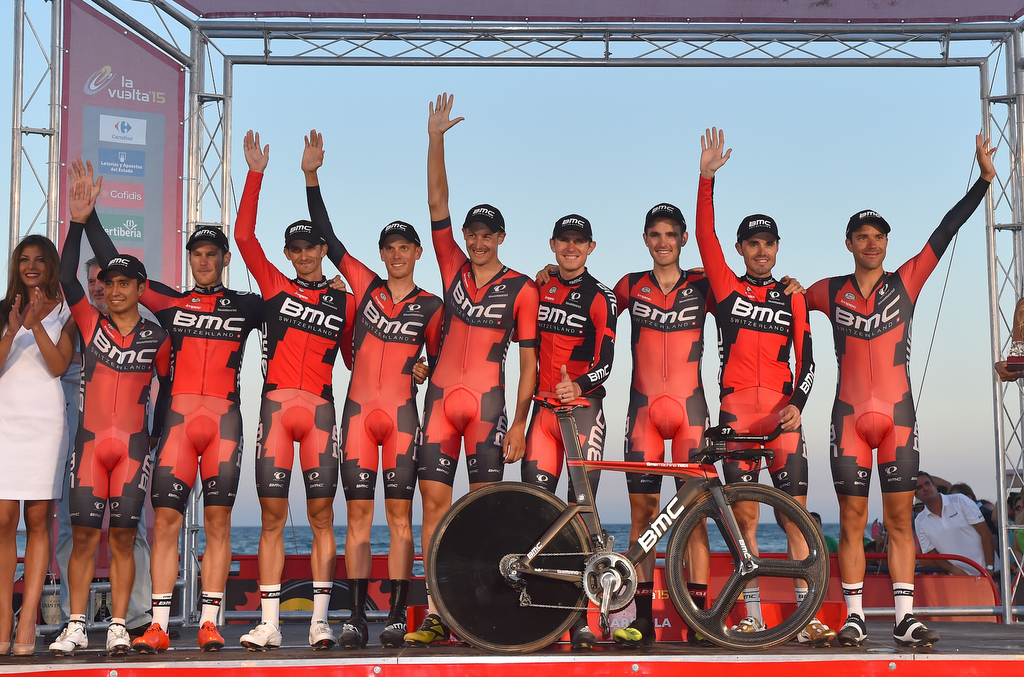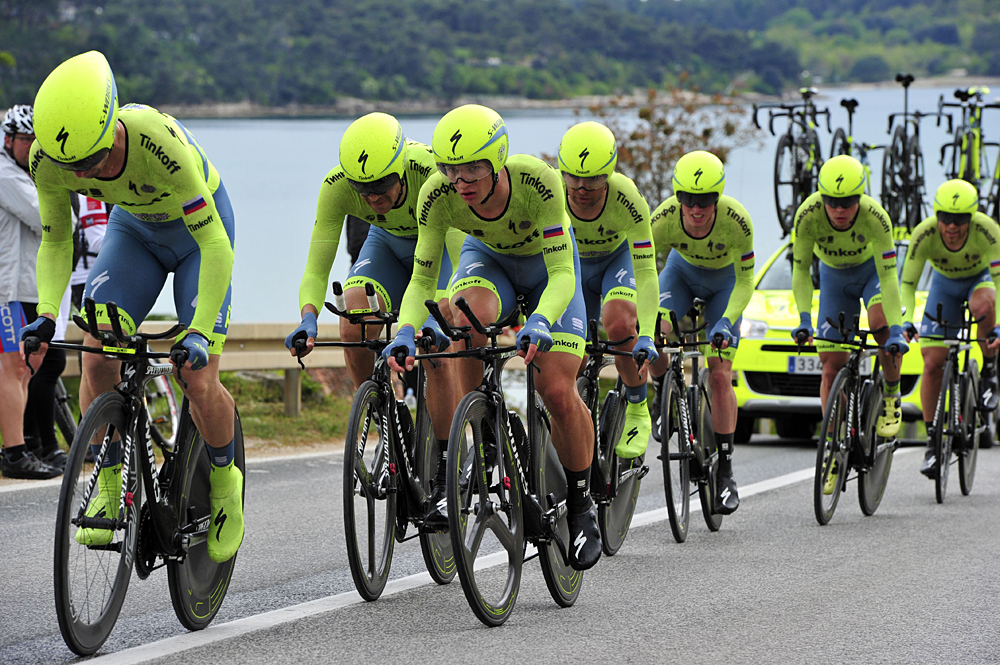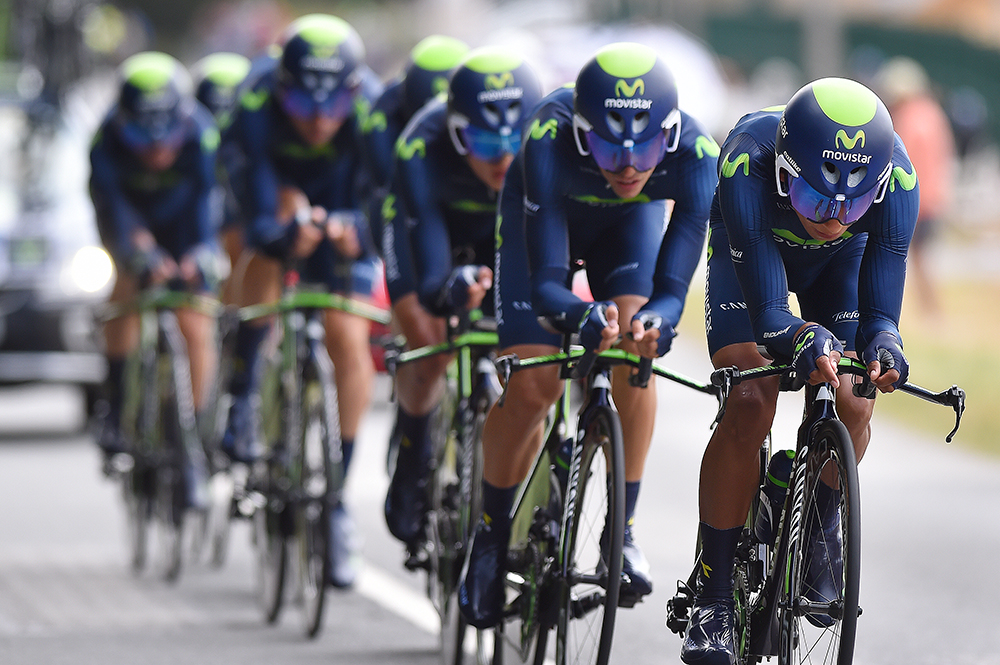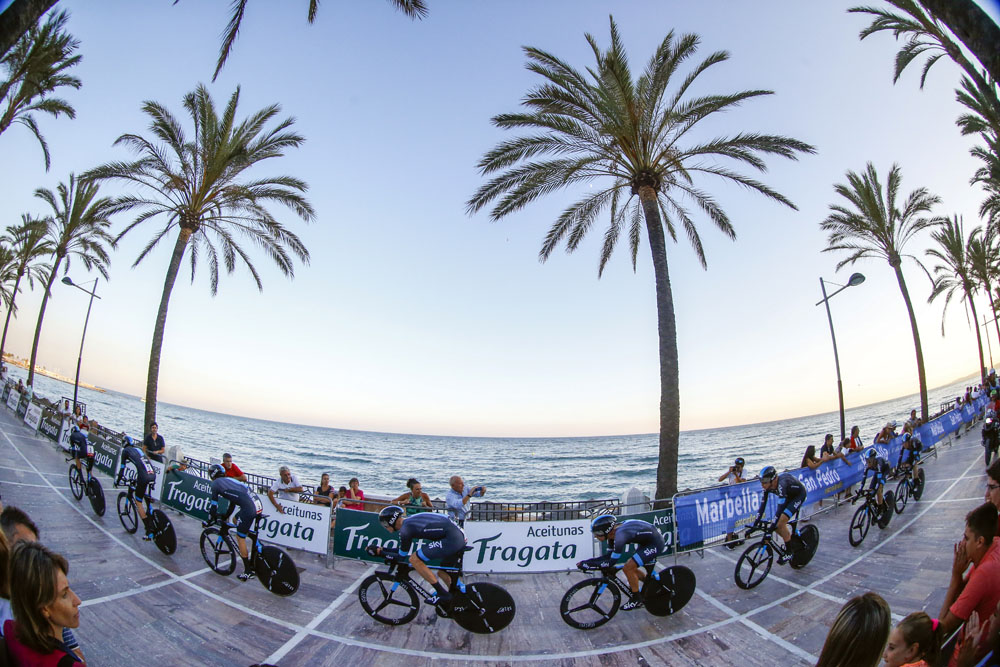Major team time trial challenge kicks off 2016 Vuelta a Espana
27.8km course a test of strength and wits




The 2016 Vuelta a Espana kicks off anything but gently on Saturday, with a medium length evening team time trial seemingly designed to reveal any potential weaknesses in the GC candidates and their teams, and perhaps create some important time gaps.
Unusually given the modern-day Vuelta's predilection for going uphill wherever and whenever possible, the 27.8-kilometre time trial between the Balneario de Laias thermal spa resort and the Parque Nautico de Castrelo de Mino bucks the trend by featuring virtually no climbing. Overall in the stage, there's an altitude difference of just 232 metres.
However, just like last year's opening TTT route along the Meditteranean coastline in Marbella, this opening stage route is once again close to a waterfront. In this case, rather than a landlocked sea, the 2016 Vuelta route circles one end of a massive (and when constructed in the late 1960s, very controversial) reservoir. But that's pretty much all it's got in common with 2015's semi-cancelled opening Vuelta team time trial across the sands and wooden decking of Marbella's beaches last year, which came within a whisker of being abandoned altogether because riders were worried about the surfaces being too risky. As Vuelta director Javier Guillen emphasised with a wry smile this January at the Vuelta presentation, the 2016 team time trial route "is run entirely on tarmac." - so there's no risk of a repeat scenario to 2015 on Saturday.
However, there are other, more certain, challenges. For one thing, the 2016 route's tricky format of two long, flatter, straightforward sections alternating with two much more technical segments will make it a real brainteaser for team managements when it comes to calculating their riders' relative strengths and where to use them to their best advantage.
There is also the length of the 2016 Vuelta's opening challenge. At 27.8 kilometres this is the longest of the last six years' opening team time trials, albeit by just 400 metres on 2013's 27.4-kilometre equivalent stage - curiously also held in Galicia. The other four TTTs were far shorter, ranging from 7.4 kilometres last year in Marbella (won by BMC), 12.6 kilometres in 2014 (Movistar), 16.2 kilometres in 2012 (Movistar) and 13.5 kilometres in 2011 (Leopard-Trek).
The 2013 team time trial in Galicia is, therefore, the best reference point, given that it is - again - flat and exposed. The much more technical course of three years ago was won by Astana, although differences were comparatively small. The Kazakh squad finished just 10 seconds ahead of second placed Radio Shack (now Trek-Segafredo) and had 16 seconds on Quick Step (Etixx) in third. Sky placed fourth at 22 seconds, Movistar were fifth at 29 seconds and Tinkoff were the furthest off the pace, in the sixth spot at 32 seconds.
Could the differences on Saturday's stage be bigger? Quite apart from very different line-ups for each team - there's no Fabian Cancellara in Trek's Vuelta line-up, for example, unlike in 2013 and Astana have no Vincenzo Nibali - the 2016 course itself contains two very long, flat segments where time trial specialists could make a massive difference.
Get The Leadout Newsletter
The latest race content, interviews, features, reviews and expert buying guides, direct to your inbox!
The first of these segments comes after the riders have rolled down the starting ramp and immediately afterwards tackled a short, steady and relatively gentle ascent out of the Balneario de Laias, on a fairly narrow access road leading out of the thermal spa. A 90-degree left-hand turn onto the main road, though, quickly moves the teams onto very different terrain.
For the next nine kilometres, the TTT route rumbles steadily along a large, broad, well-surfaced 'A' road. Barring slight curves when it moves through one small lakeside township or village or another, there are no real changes in direction or altitude. A well-coordinated team here could open up some important gaps, whilst on such an exposed, fast, course, wind direction (although not currently forecast to be strong, the weather is notoriously unpredictable in Galicia) could become a big factor, too.
The first big change of pace comes after nearly 10 kilometres when the course takes a sharp right, moving onto narrower, well-surfaced roads. There's a barely perceptible change of gradient from flat to uphill, but the road's constant series of curves - none very sharp, but relentless on this four-kilometre section - could well cause a few problems should a team's line of riders already be faltering.
What you might call 'part three' of the stage one TTT course then starts when the road takes a sweeping turn left onto a wider road and then rolls gently back downhill towards the reservoir again. This more open, broader road, is probably the straightest part of the course, lasting for roughly six kilometres and it only ends when the route hits Ribadavia, the one big town of the entire route - and famous for the three Touza sisters, who helped hundreds of Jewish refugees to escape into nearby neutral Portugal through the railway station in Ribadavia during World War II.
A sharp turn left in Ribadavia leads the riders under the railway in a sharp chicane and after a short, straight section, the route quickly heads into the last, most technical part of the course, lasting around four kilometres. A fast downhill follows combined with a series of tricky corners, and a short bridge brings the riders into the finishing straight. Given this comes right at the end of the time trial route, any errors or difficulties here will be impossible to correct.
It's unlikely any of the top names will be eliminated from the running as a result of the team time trial - it's simply not long enough. But any squad with time trial specialists will be able to make a much bigger difference than the equivalent event in 2013 and certainly compared to the other recent team time trials. And given the Vuelta has sometimes been won and lost by a handful of seconds, as was the case for Chris Froome when he lost to Juan Jose Cobo in 2011 by just 13 seconds, for example, three weeks from now, the TTT could - with the glorious benefit of hindsight - prove to have been a crunch moment of the 2016 Vuelta.
Vuelta a Espana stage 1 start times (CET)
| # | Rider Name (Country) Team | Result |
|---|---|---|
| 1 | Bora-Argon 18 | 18:26:00 |
| 2 | Direct Energie | 18:30:00 |
| 3 | Lotto Soudal | 18:34:00 |
| 4 | Astana Pro Team | 18:38:00 |
| 5 | Lampre - Merida | 18:42:00 |
| 6 | Dimension Data | 18:46:00 |
| 7 | IAM Cycling | 18:50:00 |
| 8 | Caja Rural -Seguros RGA | 18:54:00 |
| 9 | FDJ | 18:58:00 |
| 10 | Etixx - Quick Step | 19:02:00 |
| 11 | Team Katusha | 19:06:00 |
| 12 | Cofidis, Solutions Credits | 19:10:00 |
| 13 | Cannondale-Drapac Pro Cycling Team | 19:14:00 |
| 14 | Ag2r La Mondiale | 19:18:00 |
| 15 | Trek - Segafredo | 19:22:00 |
| 16 | Orica-BikeExchange | 19:26:00 |
| 17 | Team Giant Alpecin | 19:30:00 |
| 18 | BMC Racing Team | 19:34:00 |
| 19 | Team Lotto NL -Jumbo | 19:38:00 |
| 20 | Movistar Team | 19:42:00 |
| 21 | Team Sky | 19:46:00 |
| 22 | Tinkoff | 19:50:00 |
Alasdair Fotheringham has been reporting on cycling since 1991. He has covered every Tour de France since 1992 bar one, as well as numerous other bike races of all shapes and sizes, ranging from the Olympic Games in 2008 to the now sadly defunct Subida a Urkiola hill climb in Spain. As well as working for Cyclingnews, he has also written for The Independent, The Guardian, ProCycling, The Express and Reuters.
